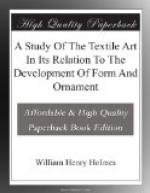[Illustration: Fig. 322. Coiled basket with ornament arranged in zigzag rays. Obtained from the Pima Indians of Arizona—1/8.]
Another choice piece, from the Pima Indians of Arizona, is given in Fig. 322. The lines of the ornament adhere exclusively to the directions imposed by the warp and the woof, the stripes of black color ascending with the turns of the fillet for a short distance, then for a time following the horizontal ridges, and again ascending, the complete result being a series of zigzag rays set very close together. These rays take an oblique turn to the left, and the dark figures at the angles, from the necessities of construction, form rows at right angles to these. A few supplementary rays are added toward the margin to fill out the widening spaces. Another striking example of the domination of technique over design is illustrated in Fig. 323.
[Illustration: Fig. 323. Coiled basket with two bands of meandered ornament. Obtained from the Pima Indians of Arizona—1/4.]
Two strongly marked, fret-like meanders encircle the vessel, the elements of which are ruled exclusively by the warp and woof, by the radiate and the concentric lines of construction. This is the work of the Pima Indians of Arizona.
[Illustration: Fig. 324. Coiled basket with geometric ornament composed of triangular figures. Obtained from the McCloud River Indians, California—1/8.]
I shall close the series with a very handsome example of Indian basketry and of basketry ornamentation (Fig. 324). The conical shape is highly pleasing and the design is thoroughly satisfactory and, like all the others, is applied in a way indicative of a refined sense of the decorative requirements of the utensil. The design is wholly geometric, and, although varied in appearance, is composed almost exclusively of dark triangular figures upon a light ground. The general grouping is in three horizontal or encircling bands agreeing with or following the foundation coil. Details are governed by the horizontal and the oblique structure lines. The vertical construction lines have no direct part in the conformation of the design excepting in so far as they impose a stepped character upon all oblique outlines.
These studies could be carried through all the types of primitive textile combination, but such a work seems unnecessary, for in all cases the elaboration in design, relieved and colored, is along similar lines, is governed by the same class of forces, and reaches closely corresponding results.
* * * * *




